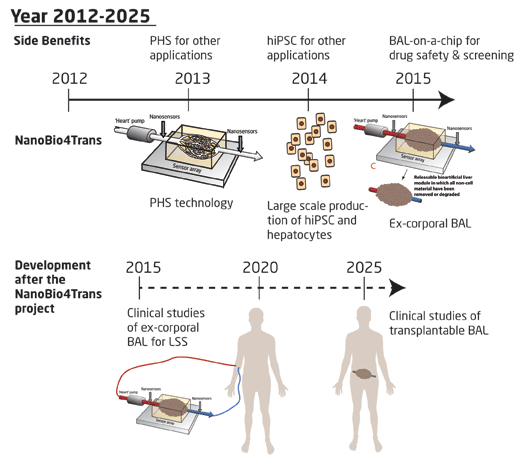Why the need of an artificial liver?
Today more people are in need of organ transplantation than there are organs available. In addition there are other problems related to organ transplantation, such as organ rejection, and the necessity to medicate the transplanted patients throughout the rest of their lives with heavy side-effects. One innovative solution to these problems is the development of bioartificial organs.
The bioartificial liver paradigm
Within the three year project period NanoBio4Trans will develop a paradigm for a fully functioning bioartificial liver (BAL). To do so, the use of human induced pluripotent stem cells (hiPSC) is essential, these cells can renew themselves, convert into any type of cell in the human body, and they are generated from adult cells, thus not causing ethical concerns. The possibility for using a patient’s own cells also means that organ rejection will be minimized as well as increase availability of lifesaving organs for transplantation in a long term perspective. Penetration of the artificial liver tissue with blood vessel-like channels and a nearby supply of the necessary growth factors are also vital factors for creating a BAL. And finally, the setup of a biosensing system for monitoring real time effects and changes during tissue growth is a significant part of the project.
Within the three year project period NanoBio4Trans will develop a paradigm for a fully functioning bioartificial liver (BAL). To do so, the use of human induced pluripotent stem cells (hiPSC) is essential, these cells can renew themselves, convert into any type of cell in the human body, and they are generated from adult cells, thus not causing ethical concerns. The possibility for using a patient’s own cells also means that organ rejection will be minimized as well as increase availability of lifesaving organs for transplantation in a long term perspective. Penetration of the artificial liver tissue with blood vessel-like channels and a nearby supply of the necessary growth factors are also vital factors for creating a BAL. And finally, the setup of a biosensing system for monitoring real time effects and changes during tissue growth is a significant part of the project.
Perspective of the NanoBio4Trans project
The BAL to be developed in NanoBio4Trans is extracorporeal with the aim of supporting liver function in patients while they wait for an appropriate donor organ, or until their own liver has recovered. Hopefully the results from this project will be the first step in the development of a transplantable bioartificial liver in the future. Another perspective from this project is the possibility of using the same method for developing other types of artificial organs.

Fig 2 Project timeline during its lifetime and beyond
Scientific and technologicl objectives of NanoBio4Trans
-
To optimise human pluripotent stem cell (hPSC) production, involving industrial banking and characterisation, as well as scaled up ststems for the production of a hiPSC library. Key production issues such as reproducibility, robustness and efficiency will be evaluated.
-
To establish and optimise directed differentiation protocols for directed hPSC fate in order to systematically and reproducibly produce key cell types - hepatocytes.
-
To develop optimised 3D liver tissue culture systems, involving construction of 3D human liver tissue structures, using: (1) commercial 3D cell culture formats, and (2) fluidic BAL-lab-on-a-Chip systems with microenvironment conditions optimised for hepatocyte tissue requirements maintained in a perfused 3D environment
-
To create scalable vascularised PHS structures with (1) primary highly branched, unidirectioal channel networks and (2) secondary arbitrary porous networks that encloses HMDs using random and structured fabrication processes. These PHSs will form the fundamental support for 3D endothelial and hepatocyte cell trowth, serving both as a mechanical and growth support system.
-
To develop and apply intra- and extracellular optical nanosensors and bioimpedance sensing strategies, multiparametric imaging and bianalysis of cells, tissues and organs (intetrity of vasculatrure, viability, O2, pH, liver function, differentiation markers, etc).